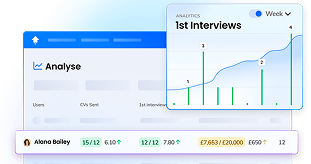5 Best Practices in Using Data Analytics for Recruitment
As discussed above, in 2024 recruitment analytics tools are a must-have for recruiters who want to remain competitive.
Get data analytics recruitment right, and it can set you on the path to massive success.
But get it wrong, and you risk taking misguided insights from inaccurate data — and ultimately making unwise business decisions.
That’s why it’s so important to implement a culture of best practice within your recruitment agency.
Here’s what you need to consider.
1. Data Quality and Management
To effectively harness the power of recruitment analytics, you need to work with high-quality data that is managed efficiently.
This means ensuring your data has no holes in it.
Delete or fix any data that is:
- Inaccurate
- Incomplete
- Inconsistent
For effective data management, it’s essential to stay on top of your data governance.
You must define roles, responsibilities, access levels, security, and guidelines for how data is to be handled within your organisation, as well as what tech you will use. This governance must take into account data privacy and compliance.
Training for any employees who will be handling data should be mandatory, and you should regularly review and optimise your data governance.
2. Continuous Learning and Adaptation
The pace of tech development is staggering — and it's only going to continue to snowball in 2024.
This means that to stay ahead of the market, you must embark on a journey of continuous learning and adaptation, encourage your recruitment team to do the same, and pass your learnings onto them.
What does this look like?
- Regular training sessions from external data science experts
- Frequent industry news updates
- Coaching
- Gaining data science qualifications
- Attending data conferences and events
- Hiring data analytics recruiters
- Blocking out time for desktop research and reading
- Following and interacting with recruitment data experts on social media
3. Balancing Data-Driven Decisions with Human Insight
Don’t throw the baby out with the bathwater.
Amid the data revolution, we don’t need to rely on gut instinct — but that certainly doesn’t mean we should ignore it.
If data is suggesting one thing, but your gut tells you that thing is wrong, you need to investigate further. With years of recruitment expertise behind you, it’s important to trust yourself.
Ideally, data-driven insights should be combined with human judgement and expertise. Data analytics tools can provide you with factual results, but it’s up to you to contextualise those results and balance their importance against other factors.
4. Fostering a Data-Driven Culture in Recruitment
To truly become a data-driven business, everyone needs to be on board.
Data must be embedded in every part of operations, from team collaboration and motivation to strategy decisions and your recruitment funnels. This means that every team member needs to understand the importance of data analytics in the recruitment process — and solid data governance — about business outcomes.
Fostering a data-driven culture in recruitment starts with education. From training sessions to data qualifications, create a comprehensive education plan for your recruiters, complete with clear milestones and targets.
Then, ensure leadership is engaged with recruitment analytics and will push their teams to improve their knowledge and skills. You can achieve this by building data into business plans and roadmaps, ensuring your metrics are aligned with business goals, and reinforcing how the use of analytics too
Next, ensure your data is transparent, and your team has access to user-friendly analytics tools. You can also use recruitment motivation software to encourage your team along their data journey by fostering healthy competition, complete with leaderboards and celebrations.

And then stay on top of it. Follow up with your leadership team and recruitment team to ensure they are truly engaging with data and using it day-to-day. You could even use an analytics tool to measure their engagement!
5. Ensuring Transparency in Analytics Processes
The importance of transparency in how data is collected, analysed, and used in recruitment decisions cannot be understated.
It’s vital not just for training and engaging your team with data — but to enable them to build analytics into their day-to-day processes.
Ensure the recruitment analytics tool you use empowers your team to easily access data, draw insights from it, and collaborate with colleagues.
Final Thoughts
Employing recruitment data analytics is non-optional for competitive agencies in 2024.
Simply put, it’s been a game-changer for the sector.
Putting user-friendly recruiting analytics software like OneUp in the hands of your team enables them to improve every single part of their performance. Meanwhile, you’re able to make confident, data-backed business strategy decisions.
Ultimately, harnessing the power of recruitment analytics significantly improves performance, and therefore boosts the bottom line.
But remember, when it comes to data, you must always keep learning, keep adapting, and keep improving.
Take the first step on your data analytics journey today and book your OneUp demo here.























